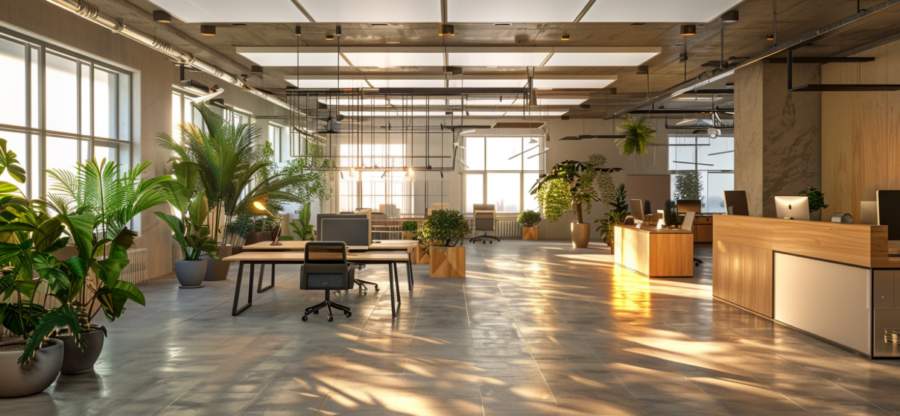Task Lighting That Doesn’t Create Tasks
Task lighting is supposed to help you focus, not leave you fiddling with anglepoise arms until you’ve reinvented origami. In an office, task lighting should give direct, glare-free illumination where people need it most: on their work surfaces. For desks, this often means adjustable LED lamps with diffused light that mimics daylight. The key is control—staff should be able to adjust their own lighting rather than endure the one-size-fits-all brilliance of ceiling panels that could illuminate a small airfield.It’s tempting to go for stylish fixtures that make a design statement, but remember: employees would rather not feel like they’re working under an interrogation lamp. Subtlety wins here. Quiet competence in the form of a lamp that just does its job will be far more appreciated than anything that belongs in a boutique hotel lobby.
Ambient Lighting That Doesn’t Suck the Soul Out of a Room
Ambient lighting is the background actor in the office drama, but like any supporting role, it has the power to ruin the show. Harsh fluorescent tubes buzzing overhead are the stuff of workplace horror stories. They flatten faces, create flicker-induced migraines, and generally make people feel as though they’ve been condemned to a 1980s call centre.Instead, think about even, indirect lighting that provides a soft wash across the space. LED ceiling panels, when chosen wisely, can mimic natural daylight without the cruel blue glare. Diffusers are a must; they spread light evenly and prevent those sinister hotspots that make it look like someone is plotting a coup under the meeting-room table.
Energy efficiency is also a serious consideration here. LEDs cost more upfront, but they pay back in reduced bills, lower maintenance, and fewer passive-aggressive memos from finance about the electricity spend.
Accent Lighting for Offices That Pretend to Care About First Impressions
Accent lighting in an office is not about turning the place into a nightclub, unless your HR team is particularly forgiving. It’s about using focused light to highlight specific areas: the reception desk, a piece of artwork, or the one plant that hasn’t yet died a slow fluorescent death.Done right, accent lighting can elevate otherwise bland spaces. A warm spotlight over the reception desk tells visitors they’re in the right place and not, say, in a dental clinic by mistake. Similarly, breakout spaces can benefit from softer lighting that suggests relaxation rather than “you’re still at work, but with beanbags.”
Accent lighting also allows businesses to add character without wallpapering the entire office in motivational quotes. A well-lit feature wall or a few strategically illuminated shelves can make a space feel curated rather than purely functional.
Wellbeing and the Bright Stuff
Lighting affects more than eyesight; it meddles with moods, hormones, and the willingness to attend another meeting about meetings. Too much glare and people complain of headaches. Too little and you’ll see productivity sink into the abyss alongside motivation. Natural light is the holy grail, but not every office comes with panoramic windows and city views. In those cases, circadian-friendly LEDs that shift their colour temperature throughout the day can help trick bodies into thinking life is not, in fact, endless fluorescent purgatory.Consider common areas as well. Kitchens and lounges benefit from warmer tones that encourage social interaction. After all, the office coffee machine is where half the business actually gets done, and nobody should be networking under light that makes them look like an extra from a zombie film.
Practical Choices That Future-Proof the Office
Even the best lighting plan is worthless if it locks you into a system that ages as fast as an uncharged smartphone. Wiring should be designed with adaptability in mind: new layouts, different desk clusters, or even the inevitable shift to hybrid work. Modular systems and smart controls let you tweak lighting as easily as moving office chairs, which is to say, with minimal swearing.Energy savings also deserve more than a token nod. Motion sensors, dimmers, and daylight sensors all reduce costs while sparing staff the task of remembering to switch off lights. It’s astonishing how many otherwise intelligent adults forget that light switches work in both directions.
- Install dimmable LEDs for flexibility and reduced glare
- Use smart systems to tailor light levels to different zones
- Plan wiring with an eye on future office layouts
- Prioritise natural light access when arranging workstations
A Lighthearted Ending
Good office lighting doesn’t shout. It doesn’t draw attention to itself or demand compliments. Its job is to keep people alert without blinding them, to flatter without fakery, to save energy without everyone noticing. When done well, lighting in the workplace becomes the quiet accomplice to productivity and wellbeing, a backstage operator pulling strings no one sees. Get it wrong, and you’ll spend years fielding complaints about headaches, sagging morale, and plants that never stood a chance. Get it right, and people might not thank you directly—but they’ll work better, feel better, and even look better on those dreaded video calls. Not bad for something as unglamorous as light bulbs and wiring.Article kindly provided by tmhugheselectrical.co.uk

